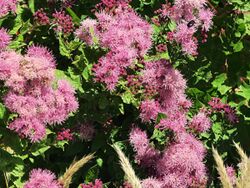Biology:Ageratina occidentalis
| Ageratina occidentalis | |
|---|---|

| |
| Regional Parks Botanic Garden Berkeley, California | |
| Scientific classification | |
| Kingdom: | Plantae |
| Clade: | Tracheophytes |
| Clade: | Angiosperms |
| Clade: | Eudicots |
| Clade: | Asterids |
| Order: | Asterales |
| Family: | Asteraceae |
| Genus: | Ageratina |
| Species: | A. occidentalis
|
| Binomial name | |
| Ageratina occidentalis (Hook.) King & H.Rob.
| |
| Synonyms[2] | |
| |
Ageratina occidentalis is a species of flowering plant in the family Asteraceae known by the common name western snakeroot or western eupatorium.[3] It is native to the western United States where it grows in several types of habitat. It is found in California , Oregon, Washington (state) , Idaho, Montana, Nevada, and Utah.[4]
Ageratina occidentalis is a rhizomatous perennial herb growing fuzzy green or purple stems to a maximum height near 70 centimeters. Its leaves are glandular and triangular, with serrated edges. The inflorescence is a dense cluster of fuzzy flower heads containing long, protruding disc florets in shades of white, pink, and blue. There are no ray florets. The fruit is an achene a few millimeters long with a rough, bristly pappus.[5]
Etymology
Ageratina is derived from Greek meaning 'un-aging', in reference to the flowers keeping their color for a long time. This name was used by Dioscorides for a number of different plants.[6]
The name Eupatorium comes from the Greek king Mithridates Eupator, who is said to have discovered that a species in the genus could be used as an antidote to a common poison.[7]
References
- ↑ "NatureServe Explorer - Ageratina occidentalis". NatureServe. 2022-06-22. https://explorer.natureserve.org/Taxon/ELEMENT_GLOBAL.2.154076.
- ↑ "Ageratina occidentalis (Hook.) R.M.King & H.Rob.". The Global Compositae Checklist (GCC). http://www.theplantlist.org/tpl1.1/record/gcc-106383.
- ↑ Nesom, Guy L. (2006), "Ageratina occidentalis", in Flora of North America Editorial Committee, Flora of North America North of Mexico (FNA), 21, New York and Oxford, http://www.efloras.org/florataxon.aspx?flora_id=1&taxon_id=250066019
- ↑ "Ageratina occidentalis", County-level distribution map from the North American Plant Atlas (NAPA) (Biota of North America Program (BONAP)), 2014, http://bonap.net/MapGallery/County/Ageratina%20occidentalis.png
- ↑ Template:Jepson Manual
- ↑ Gledhill, David (2008). "The Names of Plants". Cambridge University Press. ISBN:9780521866453 (hardback), ISBN:9780521685535 (paperback). pp 39
- ↑ Blackwell, Laird R. (2006). Great Basin Wildflowers: A Guide to Common Wildflowers of the High Deserts of Nevada, Utah, and Oregon (A Falcon Guide) (1st ed.). Guilford, Conn.: Morris Book Publishing, LLC. pp. 56. ISBN 0-7627-3805-7. OCLC 61461560.
External links
Wikidata ☰ Q4692129 entry
 |


